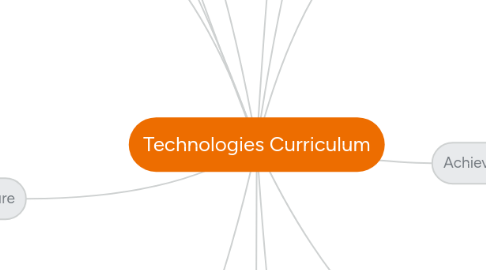
1. General Capabilities
1.1. Literacy (LIT)
1.2. Numeracy (NU)
1.3. Information and Communication technology (ICT)
1.4. Critical & Creative Thinking (CCT)
1.5. Personal & Social Capability (PSC)
1.6. Ethical Understanding (EU)
1.7. Intercultural Understanding (ICU)
2. Cross Curriculum Priorities
2.1. Aboriginal and Torres State Islander histories and cultures
2.2. Asia and Australia's Engagement with Asia
2.3. Sustainability
3. Structure
3.1. Digital Technologies
3.1.1. Knowledge and Understanding
3.1.1.1. Digital Systems
3.1.1.2. Representation of Data
3.1.2. Process and Production Skills
3.1.2.1. Defining
3.1.2.2. Designing
3.1.2.3. Implementing
3.1.2.4. Evaluating
3.1.2.5. Collaborating & Managing
3.2. Design and Technologies
3.2.1. Knowledge and Understanding
3.2.1.1. Technologies and Society
3.2.1.2. Technologies Context
3.2.2. Process and Production Skills
3.2.2.1. Investigating
3.2.2.2. Generating
3.2.2.3. Producing
3.2.2.4. Evaluating
3.2.2.5. Collaborating & Managing
4. Band Levels
4.1. Aged 5-8
4.1.1. Foundation -Year 2
4.2. Aged 8-12
4.2.1. Year 3 - Year 6
4.3. Aged 12-16
4.3.1. Year 7 - Year 10
5. Links to Other Learning Areas
5.1. The Technologies curriculum requires knowledge, understanding and skills which are learnt in other Learning Areas.
5.2. English
5.3. Mathematics
5.4. Science
5.5. Health and Physical Education
5.6. Geography
5.7. The Arts
6. National Priorities
6.1. Food and Fibre Productions
6.2. Engineering principles and systems
6.3. Food Technologies
7. Resources: edublogs
7.1. QR Code Cracker
7.1.1. http://dtm4260.edublogs.org/2015/08/06/vegie-patch-qr-code-cracker/
7.2. Phoster!
7.2.1. http://dtm4260.edublogs.org/2015/08/05/phoster/
8. Student diversity
8.1. A curriculum that allows opportunity for all students to learn in an environment that caters to their individual needs.
8.1.1. Students with disability
8.1.2. English as an additional language or dialect
8.1.3. Gifted and Talented students
9. Curriculum Aims
9.1. Develop confidence and become critical users of technologies using innovative designed solutions to generate sustainable futures.
9.2. Generate ideas and communicate these with a range of audiences using systems thinking.
9.3. Produce a range of technologies by manipulating materials, tools and equipment creatively and safely.
10. Content
10.1. Content Descriptors
10.1.1. They describe what is to be taught within the required band level such as knowledge, understandings and skills.
10.2. Content Elaborations
10.2.1. They are designed to support educators in developing an understanding of what is required within the content descriptors.
11. Key Ideas
11.1. Preferred Futures
11.2. Project Management
11.3. Thinking Skills
11.3.1. Systems thinking
11.3.2. Computational thinking
11.3.3. Design thinking
11.3.4. Critical & Creative Thinking (CCT)
12. Key Concepts
12.1. Abstraction
12.2. Data
12.3. Specification
12.4. Algorithms
12.5. Implemenatation
12.6. Digital Systems
12.7. Interactions
12.8. Impacts
13. Achievement Standards
13.1. Primary
13.1.1. Foundation to Year 2
13.1.1.1. Digital Technologies
13.1.1.1.1. By the end of Year 2, students identify how common digital systems (hardware and software) are used to meet specific purposes. They use digital systems to represent simple patterns in data in different ways.
13.1.1.2. Design & Technolgies
13.1.1.2.1. By the end of Year 2, students describe the purpose of familiar products, services and environments and how they meet the needs of users and affect others and environments.
13.1.2. Year 3 to Year 4
13.1.2.1. Digital Technologies
13.1.2.1.1. By the end of Year 4, students describe how a range of digital systems (hardware and software) and their peripheral devices can be used for different purposes.
13.1.2.2. Design & Techologies
13.1.2.2.1. By the end of Year 4 students explain how products, services and environments are designed to best meet needs of communities and their environments.
13.1.3. Year 5 to Year 6
13.1.3.1. Digital Technologies
13.1.3.1.1. By the end of Year 6, students explain the fundamentals of digital system components (hardware, software and networks) and how digital systems are connected to form networks.
13.1.3.2. Design & Technologies
13.1.3.2.1. By the end of Year 6 students describe some competing considerations in the design of products, services and environments taking into account sustainability. They describe how design and technologies contribute to meeting present and future needs
13.2. Secondary
13.2.1. Year 7 to Year 8
13.2.1.1. Digital Technologies
13.2.1.1.1. By the end of Year 8, students distinguish between different types of networks and defined purposes. They explain how text, image and audio data can be represented, secured and presented in digital systems.
13.2.1.2. Design & Technologies
13.2.1.2.1. By the end of Year 8 students explain factors that influence the design of products, services and environments to meet present and future needs.
13.2.2. Year 9 to Year 10
13.2.2.1. Digital Technologies
13.2.2.1.1. By the end of Year 10, students explain the control and management of networked digital systems and the security implications of the interaction between hardware, software and users.
13.2.2.2. Design & Technologies
13.2.2.2.1. By the end of Year 10 students explain how people working in design and technologies occupations consider factors that impact on design decisions and the technologies used to produce products, services and environments.
